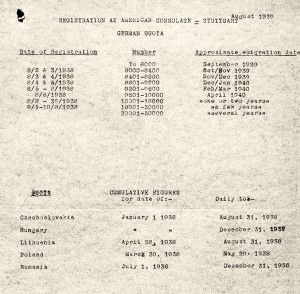 The American Quaker Florence Cook requested the American consulate in Stuttgart in 1939 for a list, which specified when a person with a specific registration number could plan on emigrating. © USHMM Washington D.C., Collection 2002.296, Case No. 1298
The American Quaker Florence Cook requested the American consulate in Stuttgart in 1939 for a list, which specified when a person with a specific registration number could plan on emigrating. © USHMM Washington D.C., Collection 2002.296, Case No. 1298
The invasion of Austria by the German Wehrmacht in March 1938 and the pogroms on 9 November 1938 convinced many Jews to emigrate. Until then they had hesitated to flee from the areas, which had come under the Nazi influence. Thereafter, only a few managed to escape. The number of inquiries submitted to the countries, which would accept these people and the hope for an easing of the related visa requirements increased as of the start of 1938. However, the international conference, which took place in the French city of Évians-les-Bains in the summer of 1938 did not provide any answers to this emergency situation. Representatives of 32 countries discussed at this conference how to handle the flood of Jewish refugees. No final decision was reached regarding an easing of the immigration regulations and an increase of the quota limits. Several countries expressed their willingness to accept unaccompanied children. Switzerland and Sweden were prepared to accept several hundred small children and teenagers, while Belgium, Holland and France were prepared to accept several thousand. The decision of the Swiss government in August 1938, in cooperation with the Nazi government in Berlin, to introduce a large, visible “J” in the passport and identity cards, enabled the Swiss civil servants to identify the Jewish refugees at the border and send them back. Even the reports of the pogroms in November 1938, which were reported in the worldwide press, did nothing to change the attitude of the foreign governments. The life-threatening situation of all Jews within the Nazi influenced areas and the deportation of Jewish men to concentration camps resulted in a wave of their relatives rushing to the foreign consulates. Those who did not apply for a visa to the USA during the summer of 1938 had to endure many years of waiting. A hectic search for distant relatives in foreign countries began. Shanghai was one of the destinations, which accepted people without a visa and without a long wait, but without sufficient financial means it was difficult to reach.
[german version]

